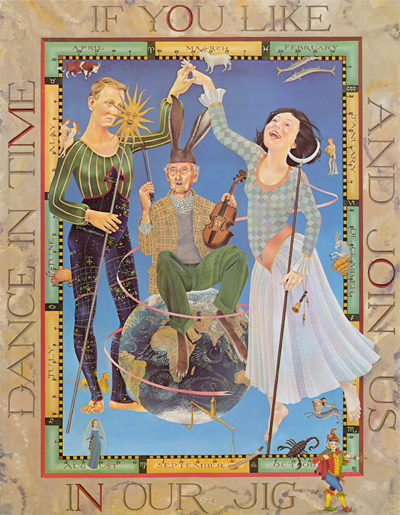Painting #2: The Moon & Sun Dance
 BORDER PHRASE: “Dance in time, if you like, and join us in our jig.”
BORDER PHRASE: “Dance in time, if you like, and join us in our jig.”
BARBED LETTER WORD: LADY
RED LETTER WORD: MOON
WORD FROM THE MASTER RIDDLE: LONG FINGER
HIDDEN HARE: Um, kind of in the middle there.
CLUES: Chock full of significance. The moon and sun’s hands are pointing to March 21-22, the spring equinox, the two days when the shadow of Catherine’s monument would point to the burial spot of the jewel. Also, it’s worth noting that the man with the violin from Painting #9 is not playing, indicating that something has stopped–in this case, the sun, so it could cast a shadow.
















{ 6 comments… read them below or add one }
The reason none of the searchers were anywhere near where the hare was buried was all a question of interpreting time! Was it ‘clock’ time or ‘sun’ time? Furthermore the medevial garb raises the possibility of working on the basis of the Julian, not the Gregorian calendar. (and what about astrological time?).
The solution to the puzzle required reference to a number of books including ‘The A.A.Illustrated Handbook for England and Wales’ (1960’s), ‘Gilbert White’s Journal’ (mid 1700’s) etcetera, but thanks to the marvels of the web (and Wiki) the research is much easier than when KW researched the project in its initial stages and full marks to him – he certainly deserves having his Amulet on display in the V and A during the Olympics!Best Regards – Brian Pike
The strands or cords holding one of the scale’s pans also cut the calendar around September 23rd/24th – the autumnal equinox – the other time of year when Catherine’s shadow would point to the correct spot 🙂
How exactly do you get “Long Finger”
Draw a line from the eye through the longest finger/toe for every creature visible in the painting. The resulting letters on the border can be rearranged to spell the phrase.
As a kid I always thought the Hidden Hare in this picture was the belt of the woman.
Looking at it now, I’m not so sure given that the other hidden ones like the bush in the village or on her swimsuit have eyes and legs.
Hi there Dan! You remember me from the early noughties. Remember when I contacted you about picture 11 and pointed out the Herring Gull in that picture, Larus argentatus? Well, I have just noticed something about picture two and I thought it would be very interesting for you to hear about.
First, go to https://www.google.com/search?q=uncle+silas+pictures&tbm=isch&source=iu&ictx=1&fir=UcfZnv3ksszGcM%253A%252CCSAROK8AZ6zRtM%252C_&usg=AI4_-kRlI1-Auz2y2gFbf1AUzoCqljuT7A&sa=X&ved=2ahUKEwiy6Yf40sfgAhU1RRUIHcQ8DJ8Q9QEwCHoECAUQFA#imgrc=UcfZnv3ksszGcM: where you will find a picture from the British film Uncle Silas (1947). In it is Greek actress Katina Paxinou, the lady with dark hair. Have a look at the way she is posing, with her head held up high. Now compare her with Kit Williams picture of the Moon, represented as a lady dancing with the sun, and notice the way Kit has her head held up high, with a huge smile on her face like Katina Paxinou. Similar? Downright near identical, I think. So could it be possible that Kit Williams based his picture of the lady moon on Greek actress Katina Paxinou? Honestly, they look so identical to each other. Then again, if Kit Williams did this, I am surprised he already knew about the film Uncle Silas, a film which has hardly been seen nowadays and is sadly not available on DVD, although I see its available on Youtube. Anyway, what do you think?